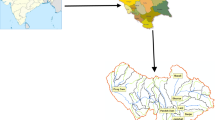Abstract
Large area of Himalayas covered with seasonal snow during winter are rapidly changing during summer, significantly affects the stream flow of many rivers originating from Himalayas. This necessitates the efficient time series monitoring of seasonal snow cover in the rugged mountainous region throughout the winter and summer periods for weekly/monthly as well as seasonal forecast of stream run-off for water management and other developmental activities.
In the present paper, the stream flow simulation model is implemented for a quantitative estimation of snowmelt run-off in winter and summer seasons for Beas and Parbati catchments of Beas river in Himachal Pradesh. The main input parameters used in the model were seasonal snow cover extent, permanent snow/glacier extent, seasonal snow line, different elevation zones, catchments areas, and basin area generated using remote sensing and GIS techniques and field data such as degree day temperature index, snowfall and rainfall. Multitemporal Advance Wide Field Sensor (AWiFS) of IRS-P6 has been used for the period between October–June for the years 2004–05, 2005–06 and 2006–07. Normalized Difference Snow Index (NDSI) technique which is based on reflectance in visible (VIS) and short-wave infrared (SWIR) bands has been used for mapping of snow covered area. The terrain characteristics have been extracted from Digital Elevation Model (DEM) of Beas basin generated using 1:50,000 scale SoI maps at 40m contour interval.
The study reveals that the month-wise discharge pattern varies from year to year; however, the stream flow rhythm for both catchments follow the same pattern. It shows that climatic parameters such as degree day temperature index, snowfall and rainfall have direct impact on daily, weekly and monthly snow melt run-off. Hence precise estimation for snow melt runoff in real time is helpful in the planning and execution of mini and micro hydel schemes.
Similar content being viewed by others
References
Day B and Goswami DC (1983) Application of Remote Sensing for seasonal runoff prediction in the Indus basin, Pakistan. In Hydrological Application of Remote sensing and remote data Transmission. Proc. Hamburg Symp., IAHS Publication No.145, pp 637–645
Gupta RP, Duggal AJ, Rao SN, Shankar G and Singhal BBS (1982) Snow cover area versus snowmelt runoff relation and its dependence on geomorphology-a study from Beas catchment (Himalayas, India). Journal of Hydrology 58: 325–339
Hall DK, Riggs GA and Salomonson VV (1995) Development of methods for mapping global snow cover using moderate resolution imaging spectroradiometer data. Remote Sens Environ 54: 127–140
Klein AG, Hall DK and Rigg GA (1998) Improving snow cover mapping in forest through the use of acanopy reflection model. Hydrological Process 12: 1723–1744
Kulkarni AV, Mathur P, Rathore BP, Alex S, Thakur NK and Kumar M (2002a) Effect of global warming on snow ablation pattern in the Himalayas. Curr Sci 83: 120–123
Kulkarni AV, Randhawa SS, Rathore BP, Bahuguna IM. and Sood RK (2002b) A snow and glacier melt runoff model to estimate hydropower potential. J Indian Soc Remote Sen 30: 221–228
Kulkarni AV, Singh SK, Mathur P and Mishra VD (2006) Algorithm to monitor snow cover AWiFS data of RESOURCESAT-1 For the Himalayan region. Int J Remote Sens 27(12): 2449–2457
Martinec J (1975) Snowmelt-runoff model for stream flow forecast. Nordic Hydrology 6(3): 145–154
Martinec J (1980) Hydrologic basin models, in remote sensing applications in agriculture and hydrology. edi. Fraysse 447–459
Martinec J, Rango A and Roberts R (1994) The Snowmelt-Runoff (SRM) User’s Manual (Ed.: MF Baumgartner). Geographica Bernesia, Department of Geography, University of Bern, Bern, Switzerland, 29p
Markham BL and Barker JL (1986) Landsat MSS and TM post calibration dynamic ranges, exoatmospheric reflectances and at satellite temperatures. EOSAT Technical Notes 1: 3–8
Mishra VD, Negi HS, Rawat A K, Chaturvedi A and Singh RP (2009) Retrieval of sub-pixel snow covered Himalayan region using medium and coarse resolution remote sensing data. Int J Remote Sens 30(18):4707–4731.
Rango A and Martinec J (1979) Application of a snowmelt-runoff model using satellite data. Nordic Hydrol. 10(4): 225–238
Rango A and Martinec J (1995) Revisiting the degree day method for snowmelt computation. Water Resources Bulletin 34(4): 657–669
Salomonson VV and Macleod NH (1972) Nimbus hydrological observations over the watersheds of the Niger and Indus Rivers. In: Fourth Annual proceedings of earth resources review, NASA Doc. Msc 05937 pp. 5.1–5.11.
Shimamura Y, Izumi T and Matsumaya H (2006) Evaluation of useful method to identify snow covered areas under vegetation — comparisons among a newly proposed snow index, normalized difference snow index, and visible reflectance. Int J of Remote Sens 27: 4867–4884
Singh P, Jain S K and Kumar N (1997) Estimation of snow and glacier-melt contributing to the Chenab river, western Himalaya. Mountain Research and Development 17(1): 49–56
Simpson JJ, Stitt JR and Sienko M (1998) Improved estimates of areal extent of snow cover from AVHRR data. J. of Hydrol. 204: 1–23
Srinivasulu J and Kulkarni AV (2004) A satellite-based spectral reflectance model for snow and glacier studies in the Himalayan terrain. Proceedings of the Indian Academy of Science “Earth and Planetary Sciences”, 113: 117–128
Xiao X, Shen Z and Qin X (2001) Assessing the potential of vegetation sensor data for mapping snow and ice cover: A Normalized Difference snow and ice index. Int J Remote Sens 22: 2479–2487
Author information
Authors and Affiliations
Corresponding author
About this article
Cite this article
Singh, M., Mishra, V.D., Thakur, N.K. et al. Impact of climatic parameters on statistical stream flow sensitivity analysis for hydro power. J Indian Soc Remote Sens 37, 601–614 (2009). https://doi.org/10.1007/s12524-009-0053-3
Received:
Accepted:
Published:
Issue Date:
DOI: https://doi.org/10.1007/s12524-009-0053-3




